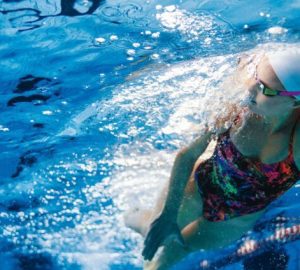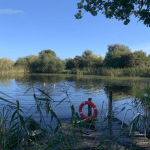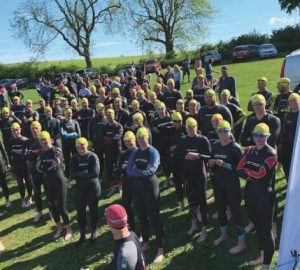Don’t be put off by your first open water swim
This is the time of year when many commercial open water venues start up for the season. If you’ve been training in a pool over the winter, it’s exciting to get outside and do something different. However, if you’re a first timer, or even an experienced open water swimmer returning after a long break, early spring water temperatures can be a real shock to the system. Be prepared, and don’t let the first swim of the season be your last.
For some, open water swimming has become a year-round activity. These will be the people who describe low double digit temperatures as ‘balmy’ and will appear as comfortable in the water as if they were in a tropical lagoon. They won’t wear wetsuits and will find it amusing to watch the wetsuited swimmers creeping cautiously back into the water in spring, gasping at the pain in their feet and keeping their hands in the air until the last moment.
If you are in the latter group, don’t let the former put you off! Additionally, and importantly, don’t be dismayed by these early season temperatures. If you don’t have much cool water experience, low double digit temperatures can feel extremely unpleasant initially but once you get used to these, higher summer temperatures will be delightful.
If you wear a wetsuit, the pain is concentrated in your feet, hands and face, and you get trickles of cold water onto your back. Stay calm. The pain is temporary. Here are some ways to cope if you’re wearing a wetsuit.
Wade in up to your waist. Sink your hands into the water and splash some on your face. Hang around here for a while. Complain and swear as necessary. Hold your hands under the water for 30 seconds or so and then lift them out to get some relief from the pain. Your feet will almost certainly hurt but the pain will stop after a few minutes so try to ignore it (you can get out and get back in again if it’s really bad; second time is easier). Still within your depth, lower yourself into the water, dip your face into the water and stand up again.
Next, try floating on your back but stay within your depth so you can stand up at any moment. This should reassure you that you won’t sink. You can also keep your hands and face out of the water if you prefer. Next try a little breaststroke, dipping your face into the water with each stroke. Finally, move into front crawl. At first you may only be able to take a few strokes before the pain in your face forces you to lift your head. Pause for a few seconds, then take another few strokes. Keep your face in the water a little longer each time. You should find that any discomfort fades after a few minutes and you start to really enjoy the swim.
Keep your first swims short – 20 to 30 minutes is plenty for this time of year. If you’re feeling adventurous, try a five minute non-wetsuit swim at the end. As your feet, hands and face are already used to the water temperature it will be relatively easy to get in and enjoy a few minutes of cool water against your skin. Dress quickly and warmly when you finish and have a hot drink.
If you’re starting out non-wetsuit, our advice would be a little different. Wearing a wetsuit, it’s fine to take your time getting used to the water. Without one, you will be losing heat too fast. We recommend wading in to waist deep as before, dunking your hands and splashing your face, bracing yourself and then getting on with it. Set yourself a target to swim towards and commit to it. Think warm thoughts and keep going. Hopefully by the time you reach your target you will feel comfortable in the water and can continue. Set yourself a time limit (we’d suggest around 20 minutes for your first swim in spring) and stick to it, especially if you’re feeling really good when your time is up.
Most importantly, for both wetsuit and non-wetsuit swimmers, don’t despair at how cold the water feels at the moment. It might not sound like much but the difference between 12 and 18 degrees, from a swimmer’s perspective, is massive. If you can cope with the former now, you will find the latter a breeze by mid-summer.
When you first get into cool water, you may think you will never cope with it, but it does get easier and soon becomes enjoyable and addictive. The body adapts. Stick with it.






